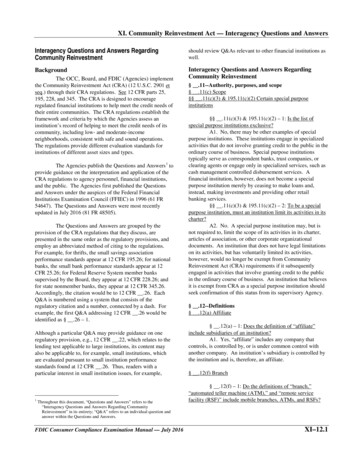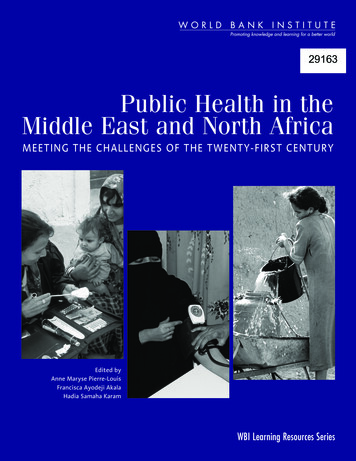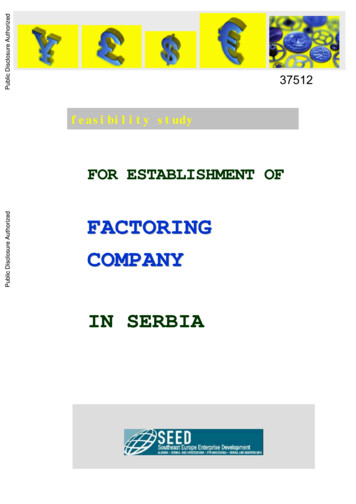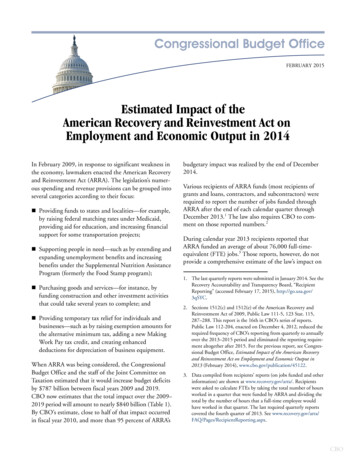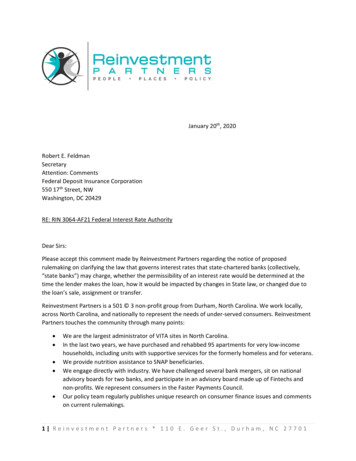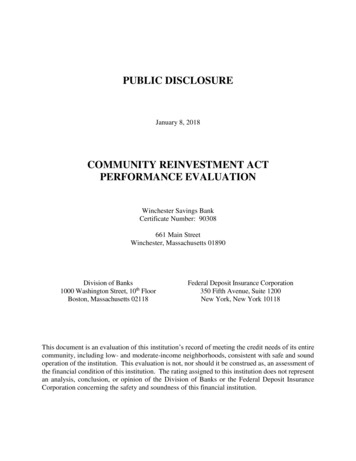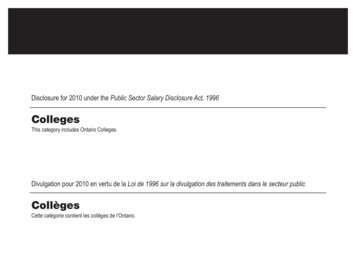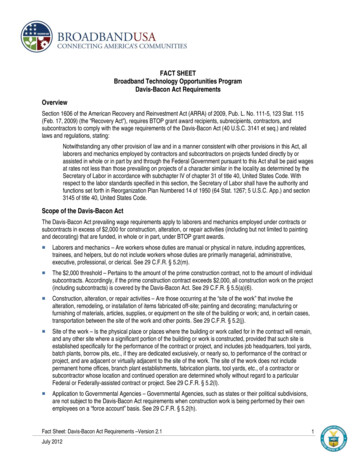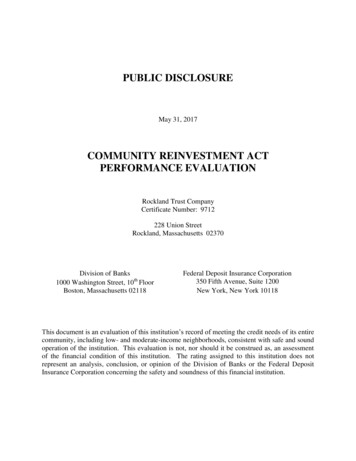
Transcription
PUBLIC DISCLOSUREMay 31, 2017COMMUNITY REINVESTMENT ACTPERFORMANCE EVALUATIONRockland Trust CompanyCertificate Number: 9712228 Union StreetRockland, Massachusetts 02370Division of Banks1000 Washington Street, 10th FloorBoston, Massachusetts 02118Federal Deposit Insurance Corporation350 Fifth Avenue, Suite 1200New York, New York 10118This document is an evaluation of this institution’s record of meeting the credit needs of its entirecommunity, including low- and moderate-income neighborhoods, consistent with safe and soundoperation of the institution. This evaluation is not, nor should it be construed as, an assessmentof the financial condition of this institution. The rating assigned to this institution does notrepresent an analysis, conclusion, or opinion of the Division of Banks or the Federal DepositInsurance Corporation concerning the safety and soundness of this financial institution.
TABLE OF CONTENTSInstitution RatingOverall Rating . 1Performance Test Ratings Table . 1Summary of Major Factors Supporting Rating . 1InstitutionScope of Evaluation . 3Description of Institution . 6Description of Assessment Area . 8Conclusions on Performance Criteria . 14Discriminatory or Other Illegal Credit Practices Review . 27AppendixScope of Evaluation . 28Division of Banks Fair Lending Policies and Procedures . 29Glossary . 31
INSTITUTION RATINGINSTITUTION’S CRA RATING: This institution is rated Satisfactory.An institution in this group has a reasonable record of helping to meet the credit needs of itsassessment area (AA), including low- and moderate-income neighborhoods, in a mannerconsistent with its resources and capabilities. The FDIC and the Commonwealth ofMassachusetts Division of Banks (Division) jointly prepared Rockland Trust Company’sCommunity Reinvestment Act (CRA) performance evaluation (PE). The following tableindicates the performance level of the bank with respect to the Lending, Investment, and ServiceTests.PERFORMANCELEVELSPERFORMANCE TESTSLending Test*Investment TestOutstandingXHigh SatisfactorySatisfactory*Service TestXXNeeds to ImproveSubstantialNoncompliance* The Lending Test is weighted more heavily than the Investment and Service Tests when arriving at anoverall rating.** FDIC rules and regulations stipulate use of a “high satisfactory” and “low satisfactory” rating forthe three tests. This jointly issued public evaluation uses the term “satisfactory” in lieu of “lowsatisfactory” for the Lending, Investment, and Service Test ratings, as the Division does not have a“low satisfactory” rating.The Lending Test is rated Satisfactory. Lending levels reflect adequate responsiveness to AA credit needs.A substantial majority of home mortgages and small business loans were made within theAA.The geographic distribution of home mortgages and small business loans reflect adequatepenetration throughout the AA.The distribution of borrowers reflects, given the product lines offered by the bank,adequate penetration among retail customers of different income levels and businesses ofdifferent size.The bank has made an adequate level of community development loans.The bank uses innovative and/or flexible lending practices in order to serve AA credit needs.1
The Investment Test is rated High Satisfactory. The bank has a significant level of qualified community development investments andgrants, occasionally in a leadership position, particularly those that are not routinelyprovided by private investors.The bank exhibits good responsiveness to credit and community economic developmentneeds.The bank makes significant use of innovative and/or complex investments to supportcommunity development initiatives.The Service Test is rated Outstanding. Delivery systems are accessible to essentially all portions of the bank’s AA.To the extent changes have been made, the bank’s opening and closing of branches has notadversely affected the accessibility of its delivery systems, particularly in low- and moderateincome geographies and/or to low- and moderate-income individuals.Services (including, where appropriate, business hours) do not vary in a way thatinconveniences certain portions of the AAs, particularly the low- and moderate-incomegeographies and/or individuals.The bank is a leader in providing community development services.2
SCOPE OF EVALUATIONGeneral InformationThis evaluation covers the period from the prior evaluation dated February 10, 2014, to thecurrent evaluation dated May 31, 2017. The FDIC and Division used Interagency Large BankCRA Examination Procedures to evaluate Rockland Trust Company’s (RTC) CRAperformance. These procedures consist of the Lending, Investment, and Service Tests.The Lending Test includes the following criteria: Lending activityAA concentrationGeographic distributionBorrower profileCommunity development lendingInnovative or flexible lending practicesThe Investment Test includes the following criteria: The dollar amount of qualified investmentsResponsiveness to credit and community development needsInnovativeness or complexity of qualified investmentsThe degree to which the qualified investments are not routinely provided by privateinvestors.The Service Test includes the following criteria: Accessibility of delivery systemsChanges in branch locationsReasonableness of business hours and servicesCommunity development servicesThe bank delineated the following Metropolitan Statistical Areas (MSAs) as its AAs: theBarnstable Town MSA, Boston-Cambridge-Newton MSA, Providence-Warwick MSA, and theWorcester MSA. All of the bank’s AA’s are subject to full scope reviews; however, these fourMSAs are contiguous and are located within the Boston-Worcester-Providence, MA-RI-NH-CTCombined Statistical Area (CSA). Therefore, examiners conducted a full-scope review of theCSA and rated this as one AA. CRA PE tables are presented in this report to enhance theanalysis and provide detailed information regarding the bank’s performance. Please note that notall percentages within tables add up to 100 percent due to rounding. This examination does notinclude any lending activity performed by affiliates.Loan Products ReviewedExaminers determined the bank’s major product lines are small business and home mortgageloans. This conclusion considered the bank’s business strategy and the number and dollar volumeof loans originated during the evaluation period. Although the bank originated small farm andconsumer loans during the evaluation period, its activities in these areas are nominal and would3
not affect Lending Test results; therefore, the Lending Test does not include these products. Thebank does not offer a small dollar loan program. Table 1 details the bank’s loan originations overthe most recent full calendar year (2016) by loan type:Table 1 - Loans Originated (2016)Loan CategoryConstruction and Land DevelopmentSecured by Farmland1-4 Family ResidentialMulti-Family ResidentialCommercial Real EstateAgricultural ProductionCommercial and IndustrialConsumer PurposeObligations of states and political subdivisions inthe U.S.Other LoansLease Financing ReceivablesGross Loans 7732,125,3890.20.0100.01814,0990.50.0100.0Source: Bank RecordsBank records indicate that the lending focus and product mix remained consistent throughoutthe evaluation period.Small business loans include loans and credit lines with origination amounts of 1 million orless categorized as secured by nonfarm nonresidential property or as commercial andindustrial loans. Examiners included small business loans reported on RTC’s 2015 and 2016CRA Small Business Loan Registers. For 2015, the bank reported 2,152 small business loanstotaling 286.6 million, and for 2016 the bank reported 2,162 loans totaling 283.4 million.The evaluation used 2010 U.S. Census data, 2015 and 2016 D&B business survey data, and2015 aggregate CRA small business loan data for comparative purposes. D&B data is onlyused as an indicator of business demographics and is not an absolute indicator of loan demand.D&B data includes all businesses in a given area that voluntarily responds to a survey request,including a large number of small businesses that have limited or no credit needs. Thebusiness survey data regularly indicates that a vast majority of businesses in a given area aresmall businesses. Aggregate CRA small business loan data for 2016 was not yet available.The evaluation also considered all home mortgage loans reported on the bank’s 2015 and 2016Home Mortgage Disclosure (HMDA) Loan Application Registers (LARs). The HMDAreportable loans include transactions for home purchases, home improvement, and refinanceloans on one-to-four family dwellings and multifamily (five or more units) properties. For 2015,the bank originated 1,601 HMDA loans totaling 501.8 million, and for 2016 the bank originated2,000 loans totaling 694.6 million. The evaluation used 2010 U.S. Census data and 2015aggregate HMDA data for comparative purposes. Aggregate HMDA data for 2016 was not yetavailable.4
Considering the loan portfolio distribution and lending activity during the evaluation period,small business and home mortgage lending received equal weight when arriving at overallLending Test conclusions. For the Lending Test, examiners reviewed the number and dollarvolume of small business and HMDA loans; however, examiners emphasized performance bynumber of loans, because the number of loans is a better indicator of the number of businessesand individuals served.The evaluation also reviewed the bank’s community development loans, investments, andservices since the prior CRA evaluation dated February 10, 2014. Qualified investmentsincluded new investments and grants, as well as outstanding investments from the priorperformance evaluation.5
DESCRIPTION OF INSTITUTIONBackgroundRTC is a state-chartered commercial bank headquartered in Rockland, Massachusetts. The bankpredominately conducts business in eastern Massachusetts as a full-service community bank andis wholly owned by Independent Bank Corp. RTC’s major business lines include commerciallending, retail banking, and investment management.Since the prior evaluation, the bank maintained two Community Development Corporations(CDCs) and two Community Development Entities (CDEs). Rockland Trust CommunityDevelopment Corporations (RTCDC) are a direct subsidiary of the bank and houses RocklandTrust Company CDC I, CDC II, CDE III, and CDE IV. During the evaluation period, the bankestablished a new CDE, the Rockland Trust Company CDE V LLC.Each of the CDEs were established for the express purpose of deploying New Markets TaxCredit (NMTC) awards by making community development loans. The NMTC program isadministered by the United States Department of the Treasury’s Community DevelopmentFinancial Institutions Fund. It was created to spur new or increased investments into operatingbusinesses or real estate projects located in low-income communities by permitting individualand corporate investors to receive tax credit by investing in certified CDEs. To qualify as aCDE, an organization must demonstrate a primary mission of serving, or providing investmentcapital for, low-income communities or low-income persons; and maintain accountability toresidents of low-income communities.The FDIC and Division last evaluated RTC’s CRA performance as of February 10, 2014, andassigned an Outstanding rating using Interagency Large Bank CRA Examination Procedures.OperationsThe bank offers a variety of business and personal banking products and services. Theseinclude commercial real estate and non-real estate loans, small business administration (SBA)loans, loans secured by one-to-four family residences, multifamily, consumer, andconstruction loans. Deposit products include checking and money market deposit accounts.Alternative banking services include remote deposit capture for business accounts and onlineand mobile banking.Including its main office, the bank operates 83 full-service branches and 2 limited-service officesin the Commonwealth of Massachusetts. The largest concentration of branches are in PlymouthCounty (33.3 percent) followed by Norfolk County (20.2 percent). Automated teller machines(ATMs) are also located at 44 of the branch locations.Since the last PE, the bank opened one branch in Norfolk County, closed five branches withinBarnstable, Plymouth, Bristol, and Middlesex Counties, relocated three branches in MiddlesexCounty, and acquired 13 branches within Norfolk, Suffolk, and Middlesex Counties. Onebranch was closed in a moderate-income census tract (CT), while the remaining branches wereeither closed or opened in middle- or upper-income CTs.The bank also acquired three institutions since the previous evaluation:6
Peoples Federal Savings Bank (Peoples Federal) was acquired on February 21,2015 and had total assets of 596 million as of December 31, 2014. The Office ofthe Comptroller of the Currency (OCC) had most recently evaluated PeoplesFederal’s CRA performance as of January 1, 2014, indicating an Outstanding rating.RTC added eight branches through this acquisition. Bank of Cape Cod was acquired on November 11, 2016 and had total assets of 262 million as of September 30, 2016. The FDIC and Division had most recentlyevaluated Bank of Cape Cod’s CRA performance as of August 22, 2011, indicatinga Satisfactory rating. RTC added one branch through this acquisition. Edgartown National Bank was acquired on May 13, 2017 and had total assets of 182 million as of March 31, 2017. The OCC had most recently evaluatedEdgartown National bank’s CRA performance as of May 12, 2014, indicating anOutstanding rating. The bank added four branches through this acquisition.Ability and CapacityRTC assets totaled approximately 7.7 billion as of March 31, 2017, and included total loansof 6.1 billion and securities of 903.9 million. Total assets increased significantly duringthe review period, driven by acquisition activities and loan growth. Specifically, total loansincreased 29.8 percent since December 31, 2013. Table 2 details the distribution of thebank’s loan portfolio:Table 2 - Loan Portfolio Distribution as of 3/31/17Loan CategoryConstruction and Land Development mmercial Real Estate2,152,72235.5Total Real Estate LoansAgricultural5,059,4868,79483.40.1Commercial and Industrial882,40814.5Consumer9,3780.2Obligations (Other than Securities and Leases) of States andPolitical ,754100.0Secured by Farmland1-4 Family ResidentialMultifamily (5 or more) ResidentialLease financing receivablesLess: Unearned IncomeTotal LoansSource: March 31, 2017 Call ReportExaminers did not identify any financial, legal, or other impediments that affect the bank’sability to meet AA credit needs.7
DESCRIPTION OF ASSESSMENT AREAThe CRA requires each financial institution to define one or more AAs within which its CRAperformance will be evaluated. The bank delineated its AA to include cities and townsdispersed among four AAs. The AAs comply with CRA technical requirements. Table 3 detailsthe communities comprising the bank’s AA by Metropolitan Divisions (MD), MSA, andcounties.Table 3 - AA CompositionAAMSAMSA or MD #CountiesBarnstable AABarnstable Town MSA12700BarnstableBoston AABoston-Cambridge-Newton MSA14454 / 15764Essex, Middlesex, Norfolk,Plymouth, SuffolkBristol AAProvidence-Warwick MSA39300BristolWorcester AAWorcester MSA49340WorcesterSource: Bank RecordsAs previously indicated, this evaluation presents all delineated AAs as one AA since all AAs arecontiguous and comprise the Boston-Worcester-Providence, MA-RI-NH-CT CombinedStatistical Area (CSA) #148.Economic and Demographic DataThe CSA includes all 854 CTs in the 4 individual AAs. These tracts reflect the following incomedesignations according to the 2010 U.S. Census: 9816733823813low-income tracts,moderate-income tracts,middle-income tracts,upper-income tracts, andcensus tracts with no income designation.Table 4 details demographic data for the CSA:8
Table 4 – Demographic Information of the CSADemographic Characteristics#Geographies (Census Tracts)Low% of #Moderate% of #Middle% of #Upper% of #NA*% of #85411.519.639.627.91.5Population by Geography3,756,5579.418.242.130.20.1Housing Units by Geography1,619,9898.918.744.328.10.0Owner-Occupied Units by Geography889,7903.312.848.035.90.0Occupied Rental Units by Geography564,64217.727.536.318.40.0Vacant Units by Geography165,5579.219.751.619.50.0Businesses by 7.242.40.0Farms by GeographyFamily Distribution by Income LevelHousehold Distribution by IncomeLevelMedian Family Income MSA - 12700 BarnstableTown, MA MSA75,056 Median Housing ValueMedian Family Income MSA - 14454 Boston, MAMD83,664Median Family Income MSA - 15764 CambridgeNewton-Framingham, MA MD90,625Median Family Income MSA - 39300 ProvidenceWarwick, RI-MA MSA70,496Median Family Income MSA - 49340 Worcester,MA-CT MSA77,128413,264Median Gross Rent1,139Families Below Poverty Level7.3%Source: 2010 U.S. Census and 2016 D&B Data(*) The NA category consists of geographies that have not been assigned an income classification.There are 1.6 million housing units in the CSA, 54.9 percent of which are owner-occupied,34.9 percent are occupied rental units, and 4.4 percent are vacant. The geographic distributioncriterion compares home mortgage loans to the distribution of owner-occupied housing units. Asshown in the table above, there are limited opportunities for owner-occupied home mortgagelending in low- and moderate-income tracts. Only 3.3 percent of owner-occupied units are in lowincome tracts and 12.8 percent are in moderate-income tracts.Examiners used the 2015 and 2016 FFIEC-updated median family income levels to analyzehome mortgage loans under the Borrower Profile criterion. Table 5 details the low-, moderate-,middle-, and upper-income categories by MD and MSA:9
Table 5 – Median Family Income RangesLow 50%Median Family Incomes2015 ( 80,300)2016 ( 77,100)2015 ( 90,000)Moderate50% to 80%Middle80% to 120%Barnstable Town, MA MSA Median Family Income (12700) 40,150 40,150 to 64,240 64,240 to 96,360Upper 120% 96,360 61,680 to 92,520 92,520Boston, MA MD Median Family Income (14454) 45,000 45,000 to 72,000 72,000 to 108,000 108,000 38,550 38,550 to 61,680 72,640 to 108,960 108,960Cambridge-Newton-Framingham, MA MD Median Family Income (15764)2015 ( 101,700) 50,850 50,850 to 81,360 81,360 to 122,040 122,0402016 ( 98,600) 78,880 to 118,320 118,320Providence-Warwick, RI-MA MSA Median Family Income (39300) 37,200 37,200 to 59,520 59,520 to 89,280 89,2802016 ( 90,800)2015 ( 74,400)2016 ( 73,100)2015 ( 81,500)2016 ( 78,500) 45,400 49,300 45,400 to 72,640 49,300 to 78,880 58,480 to 87,720 87,720Worcester, MA-CT MSA Median Family Income (49340) 40,750 40,750 to 65,200 65,200 to 97,800 97,800 36,550 39,250 36,550 to 58,480 39,250 to 62,800 62,800 to 94,200 94,200Source: FFIEC Median Family Income DataThe analysis of small business loans under the Borrower Profile criterion compares thedistribution of the bank’s small business loans to the distribution of businesses by Gross AnnualRevenue (GAR) level.In 2016, service industries represent the largest portion of businesses at 49.6 percent; followed byretail trade (13.2 percent); finance and insurance (10.1 percent); construction (8.2 percent); andnon-classifiable industries (7.3 percent). In addition, 72.4 percent of businesses within the areahave four or fewer employees, and 90 percent operate from a single location. According to the2016 D&B data, there were 273,950 non-farm businesses operating within the CSA. GARs forthese businesses are detailed below. 83.1 percent have 1 million or less.7.2 percent have more than 1 million.9.7 percent have unknown revenues.According to the January 2017 Moody’s Economy.com (Moody’s), the Barnstable MSAeconomy is advancing, but the pace exhibits deceleration. However, job growth over the lastyear exceeds that in the northeast and the nation, bringing the unemployment rate down to a 16year low of 3.1 percent. The biggest challenge of the area is the distribution of various agegroups, as one-third of the population is 65 and older. The working age population has beenshrinking for more than a decade attributed to the number of retirees. The area’s housingmarket is unique as second or vacation homes account for a larger than average share of thehousing stock. While homeownership and vacancy rates are below average, single-family homeconstruction is increasing. Top employers in the area are Cape Cod Healthcare Inc., Woods10
Hole Oceanographic Institution, Hawthorne Motel, Steamship Authority and JML Care Center.According to the January 2017 Moody’s, the Boston MD is one of New England’s topperformers directly attributable to growth in technology and a thriving healthcare industry.Boston is highly dependent on healthcare in providing jobs and income since the state budgetfavors medical service providers. Employment in Boston’s financial sectors reflected stronggains as securities firms accounted for 40 percent of the jobs. Boston’s housing prices are about10 percent above the prerecession peak and reporting record highs directly attributed to lowinventories. According to the Greater Boston Realtors Association, unsold inventory is downsharply from a year ago and higher interest rates have not restrained buyers demand in theBoston MD. Top employers in the area are Partners HealthCare, University of Massachusetts,Steward Health Care System, Beth Israel Deaconess Medical Center, and State StreetCorporation.According to the January 2017 Moody’s, the Cambridge-Newton-Framingham MD is performingwell above the national average. With unemployment at 2.5 percent, the labor force is growingfaster than the national rate. The area relies heavily on the education and high-tech industries foremployment. Above-average household incomes are attributed to the higher skilled workforce,contributing to record high housing prices. Single-family and multi-family housing permits forconstruction or home improvement has declined in the fourth quarter of 2016. Lower inventoriesin housing have kept house prices and rental rates high. Top employers in the area are HarvardUniversity, Massachusetts Institute of Technology, Biogen IDEC, and Novartis Institute ofBiomedical Research, and Mount Auburn Hospital.According to the January 2017 Moody’s, the Providence-Warwick RI-MA reflected a slowdownin employment during the fourth quarter of 2016. The area has strong ties to the rapidlygrowing Boston areaThe competitive salaries offered in Boston impacted the ProvidenceWarwick area while an influx of residents commutes to Boston for work. However, the incomegenerated from Boston provides a boost in consumer spending in the Providence-Warwick area.Higher paying management jobs also expanded with notable additions last year at Hasbro andCVS Healthcare Corporation. New residential construction has also reflected a slowdownfollowing the surge in multifamily building. Housing prices in the area are slightly higher thanthe national average. Top employers in the area are Lifespan, Care New England, CVS HealthCorporation, Citizens Financial Group Inc., and General Dynamic Electric Boat.According to the January 2017 Moody’s, the Worcester MA-CT labor markets slowed in thefourth quarter of 2016 due to an aging population and the lack of skilled labor. A large numberof healthcare providers are concentrated within the area, which accounts for one-fifth of thelabor force. Other industries such as manufacturing reflected better performance whencompared with similar industries nationally. Business costs in this area are lower whencompared to areas such as Boston. However, the industrial vacancy rate is extremely high asmuch of the space is undesirable to modern manufacturers because of the prohibitive cost ofnecessary upgrades and high business tax rates. Existing home sales have also picked up,driving inventories to record lows and encouraging new construction. Top employers in the areaare the University of Massachusetts Memorial Health Care, University of Massachusetts MedicalSchool, Fallon Clinic, Reliant Medical Group, and Saint Vincent’s Hospital.11
Data obtained from the U.S. Bureau of Labor and Statistics on the unemployment rate in the AAsas compared to the state of Massachusetts and the National Average is shown on Table 6. Theunemployment rate in each of the areas has trended downward in 2016; however, with theexception of the National Average and the Providence-Warwick, RI-MA MSA, there was slightincrease in the unemployment rate for the state and other areas as of April 2017. Table 6 detailsthe unemployment rate for each individual AA:Table 6 - Unemployment RatesArea2015%6.23.83.65.24.84.65.0Barnstable Town, MA MSABoston, MA MDCambridge-Newton-Framingham, MA MDProvidence-Warwick, RI-MA MSAWorcester, MA-CT MSAStateNational Average2016%3.82.32.34.23.02.84.7April 2017%4.73.23.24.24.13.84.5Source: Bureau of Labor StatisticsCompetitionThe bank operates in a highly competitive market for deposits and loans. According to June 30,2015 FDIC Summary of Deposits data, 213 financial institutions operated 1,359 branch officeswithin the bank’s AA. The bank ranked fourth with a 6.4 percent deposit market share in theAA. The market leaders were primarily large national banks with numerous offices throughoutthe metropolitan areas, including Citizen’s Bank, N.A; Bank of America, N.A; Santander BankN.A. Eastern Bank also ranked ahead of RTC in deposit market share.HMDA and small business loan aggregate data reflects the level of demand for home mortgageand small business loans and are included as a contextual barometer of lending conditions in theAA. Based on 2015 home mortgage loan aggregate data, the competition for home mortgageloans in the bank’s AA is strong. During 2015, 636 lenders reported 130,634 loans purchased ororiginated, totaling approximately 46.7 billion within the AA. The bank ranked 20th with a 1.1percent market share.The five most prominent home mortgage lenders have a nationwide presence, and their lendinglevels accounted for over 20.0 percent of the total market share. They were primarily largenational banks with numerous offices throughout the metropolitan area, including J.P. MorganChase Bank N.A.; LoanDepot.com LLC; Wells Fargo Bank N.A.; Quicken Loans; and Bank ofAmerica N.A. Aggregate data for 2016 was not available at the time of the evaluation.Aggregate small business lending data for 2015 showed that 181 institutions reported 116,406small business loans in the AA. The bank ranked 14th 1,983 loans and a 1.8 percent marketshare. Additionally, the five most prominent small business lenders have a nationwide presence,and their lending levels accounted for 61.3 percent of the total market share. The market leaderswere primarily large national banks with numerous offices throughout the metropolitan area thatincludes American Express Federal Savings Bank; Bank of America, N.A.; Capital One Bank,N.A.; Citibank, N.A.; and Chase Bank, N.A. Aggregate data for 2016 was not available duringthe time of the evaluation.12
Community ContactAs part of the CRA evaluation process, examiners contacted third parties to gain performancecontext in the assessment of the credit and community development needs of the bank’s AA.Relevant information from the contacts assists in determining whether local financial institutionsare responsive to the credit needs of the community, and what community developmentopportunities, if any, are available. Two existing community contacts were utilized inconjunction with this evaluation.Examiners reviewed an existing contact conducted with a representative of an economicdevelopment organization primarily serving the southeast quadrant of Massachusetts. Theorganization also promotes growth supporting small businesses by providing flexible financingoptions. The contact indicated that the area has reached max capacity to grow and prospergiven the demographics of the workforce. For example, the economic conditions are limitedbecause of the lack of the skilled labor available. Since the area is heavily concentrated bytechnology and healthcare industries, more high skilled workers are needed to fill jobs in thearea. As a result, the current market conditions appear to be unfavorable for businesses.However, a majority of the financial institutions in the area reflected involvement withaffordable housing and economic development activities. RTC was specifically mentioned asan institution involved in providing community development initiatives.Examiners also considered an existing contact co
Rockland Trust Company Certificate Number: 9712 228 Union Street Rockland, Massachusetts 02370 . Alternative banking services include remote deposit capture for business accounts and online and mobile banking. Including its main office, the bank operates 83 full-service branches and 2 limited-service offices
